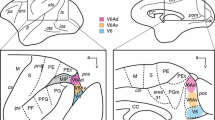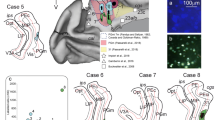Summary
Radioactive amino acids were injected into restricted regions of the globus pallidus of rhesus macaques to allow identification of the organization and courses of efferent pallidal projections. The previously identified projection of the internal pallidal segment (GPi) to ventral thalamic nuclei showed a topographic organization, with the predominant projection from ventral GPi being to medial and caudal ventralis anterior (VA) and lateralis (VL) and from dorsal GPi to lateral and rostral VA and VL. Pallidal efferent fibers also extended caudally and dorsally into pars caudalis of VL, but they spared the portion of pars oralis of VL shown by others to receive input from the cerebellum. In addition to centromedian labeling in all animals, the parafascicular nucleus was also labeled when isotope was injected into dorsal GPi. The medial route from GPi to the midbrain tegmentum was more substantial than has been shown before, and along this route there was an indication that some fibers terminated in the prerubral region. The projection to the pedunculopontine nucleus was extensive, and fibers continued caudally into the parabrachial nuclei.
Pallidal projections to the thalamus seem to be topographically organized but spare thalamic regions that interact with area 4. Caudally directed efferent fibers follow multiple routes and extend more caudally than to the pedunculopontine nuclei.
Similar content being viewed by others
Abbreviations
- Cd:
-
caudate nucleus
- CM:
-
centromedian nucleus
- CT:
-
central tegmental tract
- DPCS:
-
decussation of superior cerebellar peduncle
- F:
-
fornix
- FLM:
-
medial longitudinal fasciculus
- GPe:
-
globus pallidus, pars externa
- GPi:
-
globus pallidus, pars interna
- HbL:
-
lateral habenular nucleus
- HbM:
-
medial habenular nucleus
- Is:
-
interstitial nucleus
- LM:
-
medial lemniscus
- MD:
-
dorsomedial nucleus
- PbL:
-
lateral parabrachial nucleus
- PbM:
-
medial parabrachial nucleus
- PCS:
-
superior cerebellar peduncle
- Pf:
-
parafascicular nucleus
- PPN:
-
pedunculopontine nucleus
- Put:
-
putamen
- R:
-
reticular nucleus
- Rmg:
-
red nucleus, pars magnocellularis
- Rpc:
-
red nucleus, pars parvocellularis
- S:
-
stria medullaris
- SI:
-
substantia innominata
- SNc:
-
substantia nigra, pars compacta
- SNr:
-
substantia nigra, pars reticulata
- St:
-
subthalamic nucleus
- ST:
-
stria terminalis
- THI:
-
habenulointerpeduncular tract
- TM:
-
tuberomamillary nucleus
- TMT:
-
mamillothalamic tract
- VA:
-
nucleus ventralis anterior
- VAmg:
-
nucleus ventralis anterior, pars magnocellularis
- VAp:
-
nucleus ventralis anterior, pars principalis
- VI:
-
nucleus ventralis intermedius
- VLc:
-
nucleus ventralis lateralis, pars caudalis
- VLm:
-
nucleus ventralis lateralis, pars medialis
- VLo:
-
nucleus ventralis lateralis, pars oralis
- VPL:
-
nucleus ventralis posterior lateralis
- X:
-
area X
References
Anderson ME (1977) Discharge properties of basal ganglia neurons during active maintenance of postural stability and adjustment to chair tilt. Brain Res 143: 325–338.
Carpenter MB (1976) Anatomical organization of the corpus striatum and related nuclei. In: Yahr A (ed) The basal ganglia. Raven, New York, pp 1–36.
Coote JH, Hilton SM, Zbrozyna W (1973) The pontomedullary area integrating the defense reaction in the cat and its influence on muscle blood flow. J Physiol (Lond) 229: 257–274.
Cowan WM, Powell TPS (1966) Striopallidal projection in the monkey. J Neurol Neurosurg Psychiatry 29: 426–439.
Cowan WM, Gottlieb EI, Hendrickson AE, Price JL, Woolsey TA (1972) The autoradiographic demonstration of axonal connections in the central nervous system. Brain Res 37: 21–51.
DeLong M (1971) Activity of pallidal neurons during movement. J Neurophysiol 34: 414–427.
Desiraju T, Purpura D (1969) Synaptic convergence of cerebellar and lenticular projections to thalamus. Brain Res 15: 544–547.
DeVito JL (1969) Projections from the cerebral cortex to intralaminar nuclei in monkey. J Comp Neurol 136: 193–202.
DeVito JL, Smith OA Jr (1964) Subcortical projections of the prefrontal lobe of the monkey. J Comp Neurol 123: 413–424.
DeVito JL, Anderson ME, Walsh KE (1980) A horseradish peroxidase study of afferent connections of the globus pallidus in Macaca mulatta. Exp Brain Res 38: 65–73.
Filion M, Harnois C (1978) A comparison of projections of entopeduncular neurons to the thalamus, the midbrain, and the habenula in the cat. J Comp Neurol 181: 763–780.
Grofova I (1975) The identification of striatal and pallidal neurons projecting to substantia nigra. An experimental study by means of retrograde axonal transport of horseradish peroxidase. Brain Res 91: 286–291.
Herkenham M, Nauta WJH (1977) Projections of the habenular nuclei in the rat. Anat Rec 187: 603.
Kievit J, Kuypers HGJM (1977) Organization of the thalamocortical connections to the frontal lobe in the rhesus monkey. Exp Brain Res 29: 299–322.
Kim R, Nakano J, Hayaraman A, Carpenter MB (1976) Projections of the globus pallidus and adjacent structures. An autoradiographic study in the monkey. J Comp Neurol 196: 263–289.
King GW (1980) Topology of ascending brainstem projections to nucleus parabrachialis in the cat. J Comp Neurol 191: 615–638.
Künzle H (1975) Bilateral projections from precentral motor cortex to the putamen and other parts of the basal ganglia. An autoradiographic study in Macaca fascicularis. Brain Res 88: 195–209.
Kuo JS, Carpenter MB (1973) Organization of pallidothalamic projections in the rhesus monkey. J Comp Neurol 151: 201–236.
Kusama T, Mabuchi M (1970) Stereotaxic atlas of the brain of Macaca fuscata. University Park Press, Baltimore.
Nauta HJW (1979) Projections of the pallidal complex. An autoradiographic study in the cat. Neuroscience 4: 1853–1873.
Nauta WJH, Mehler WR (1966) Projections of the lentiform nucleus in the monkey. Brain Res 1: 3–42.
Olszewski J (1952) The thalamus of the Macaca mulatta. Karger, Basel.
Percheron G (1977) Thalamic territory of cerebellar afferents and lateral region of thalamus of macaque in Stereotaxic ventricular coordinates. J Hirnforsch 18: 375–400.
Rosene DL, Mesulam MJ (1978) Fixation variables in horseradish peroxidase neurohistochemistry. I. Effect of fixation time and perfusion procedures upon enzyme activity. J Histochem Cytochem 26: 28–39.
Strick P (1976) Anatomical analysis of ventrolateral thalamic input to primate motor cortex. J Neurophysiol 39: 1020–1031.
Szabo J (1967) The efferent projections of the putamen in the monkey. Exp Neurol 19: 463–476.
Szabo J (1970) Projections from the body of the caudate nucleus in the rhesus monkey. Exp Neurol 27: 1–15.
Tracey DJ, Asanuma C, Jones EG, Porter R (1980) Thalamic relay to motor cortex. Afferent pathways from brain stem, cerebellum, and spinal cord in monkeys. J Neurophysiol 44: 532–554.
Ueki M, Uno M, Anderson M, Yoshida M (1977) Monosynaptic inhibition of thalamic neurons produced by stimulation of substantia nigra. Experientia 33: 1480–1481.
Uno M, Yoshida M (1975) Monosynaptic inhibition of thalamic neurons produced by stimulation of the pallidal nucleus in cats. Brain Res 99: 377–380.
Uno M, Ozawa N, Yoshida M (1978) The mode of pallidothalamic transmission investigated with intracellular recording from cat thalamus. Exp Brain Res 33: 493–507.
Woodburne RT, Crosby EC, McCotter RE (1946) The mammalian midbrain and isthmus regions. Part II. The fiber connections. A. The relations of the tegmentum of the midbrain with the basal ganglia in Macaca mulatta. J Comp Neurol 85: 67–92.
Author information
Authors and Affiliations
Additional information
Supported by National Institutes of Health, grant RR00166, Rehabilitation Services Administration, grant 16-P-56818, and PHS grant NS10804
Rights and permissions
About this article
Cite this article
DeVito, J.L., Anderson, M.E. An autoradiographic study of efferent connections of the globus pallidus in Macaca mulatta . Exp Brain Res 46, 107–117 (1982). https://doi.org/10.1007/BF00238104
Received:
Published:
Issue Date:
DOI: https://doi.org/10.1007/BF00238104




